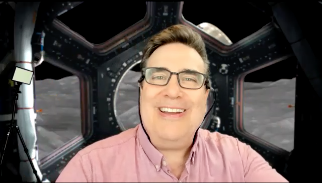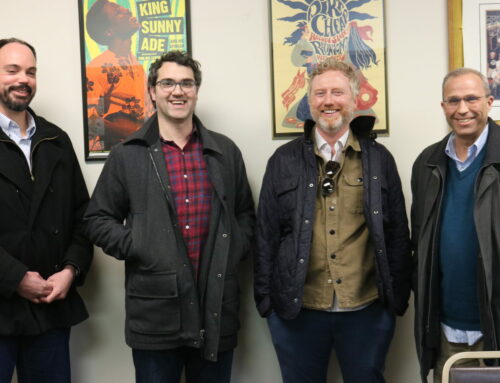By Kellyn Vuchetich
July 7, 2021
 Michael Sibbernsen joins our Zoom meeting from what appears to be The International Space Station. In reality he may not be an astronaut orbiting Earth, but as the CEO of Branched Oak Observatory and a lecturer of Astronomy and Physics at UNL, he’s a bit of an expert when it comes to the night sky.
Michael Sibbernsen joins our Zoom meeting from what appears to be The International Space Station. In reality he may not be an astronaut orbiting Earth, but as the CEO of Branched Oak Observatory and a lecturer of Astronomy and Physics at UNL, he’s a bit of an expert when it comes to the night sky.
For nearly a decade Sibbernsen has volunteered as a NASA Solar System Ambassador, spreading awareness about NASA’s work in space science. He formerly worked for the NASA Nebraska Space Grant providing research funding for university-level students and professors. Given these impressive credentials, he was the ideal person to tell me more about Branched Oak Observatory’s upcoming events while providing some tips for stargazing in and around Lincoln this summer.
Branched Oak Observatory may not be open every evening or weekend, but they aim to open twice per month. Most of their events are called “Star Parties,” and are typically held around the new moon to allow for optimal viewing of galaxies, nebulas, star clusters, and other objects in the night sky. “We’re far enough away from city lights that you can easily see the Milky Way; you can easily see a huge number of stars; you have some really nice dark skies, but at the same time we’re close enough to a major populated area that people are willing to come out and see us,” says Sibbernsen.
This upcoming weekend, BOO will be hosting two events in succession. Friday, July 9 they’re partnering with James Arthur Vineyard for a Wine and Stargazing event. “We like to think the ‘star’ of the show is the night sky,” jokes Sibbernsen. “Anyone who’s enjoying the wine and the appetizers we take on a tour of the observatory once it gets dark enough, then we show some beautiful objects in the night sky.” Tickets for this event can be purchased through James Arthur Vineyard.
The following night is the Cluster Busters Star Party, in which telescopes will be pointed towards a number of different star clusters. This free event will begin at 9:30pm and continue until midnight.
Later in the season, August 13, BOO is hosting a Star Party to view the Perseid Meteor Shower from 11 p.m. to 2 a.m. “A meteor shower is caused when the earth passes through the debris that’s left over, generally by comets that have passed by that kind of leave bread crumbs along the path.” explains Sibbernsen. “Generally meteor showers are better after midnight, so we are having a special late night star party. We’ve done this before and we get a really great turnout, so there are a lot of night owls out there!”
Those who stay up late stargazing will also get a preview of the night skies to come. “You almost get a sneak peek of what you’re going to be seeing in the night sky in the following month because of the movement of the sky throughout the evening,” Sibbernsen says. “Stars are rising in the East, they’re going down in the West. That’s just because of what’s called the diurnal motion: the rotation of the earth. If you wait until after midnight in the early hours, you’re going to see a month from that time, or some point in the future from that time.”
Sibbernsen offers one more piece of advice for viewing the Perseids and other meteor showers this summer: “The problem that most people have is that they’ll just kind of stick their head out the back door of their house, wait maybe 30 seconds, not see a thing and go back inside again,” he says. “For any meteor shower, you really do need to get out of town and away from city lights. It’s a good idea to go out with a friend so people can look in different directions. The more eyes you have the more chance you have of seeing a few meteors.”
To wrap up Branched Oak Observatory’s summer calendar is their 7th Annual Star-BQ on September 4. While Star Parties typically see a turnout of 15 to 80 people, around 500 to 600 attendees are expected at the Star-BQ. “We’ll have food trucks, live music, special solar telescopes that allow you to do what you’re always told never to do and look at the sun; safely look at sun spots, solar prominences, and other things,” Sibbernsen says. “We’ll have more telescopes on the field than we ever have because other area astronomers help us celebrate our great Star-BQ.” There will also be activities for kids, science demonstrations, and an appearance from the 501st Legion dressed in full Storm Trooper costume.
In addition to their special events, BOO offers a number of resources for local astronomy buffs and beginners alike. These include an astronomy library available in the visitors center and a free telescope checkout program made possible by the NASA Nebraska Space Grant.
For those looking for additional resources, Sibbersen recommends apps such as Sky Safari and Sky Walk, which utilize a device’s compass to locate and identify objects in the sky. “What’s really fun about these is it can be a cloudy day or night and you can still enjoy and learn about the sky. It allows you X-Ray vision, and you can see through walls and see through clouds, even see through the earth and see the constellations and stars that are below.”
Websites such as skymaps.com and heavens-above.com are ideal for educators, scout leaders, or individuals interested in creating a map of the sky configured for their location. Sibbernsen suggests Stellarium for serious stargazers in search of high-quality planetarium software. He notes that the Branched Oak Observatory website is currently under construction, but it will soon be up and offering additional links and suggested resources.
Sibbernsen clued me in on a couple of other astronomical events to keep an eye out for this summer. “This summer more and more planets are going to be up, and there’s kind of an old adage that stars twinkle but planets don’t, and that actually does hold true if the planets are high enough in the atmosphere above the horizon,” says Sibbernsen. “Regardless of where you are you can keep an eye out for these planets, for the moon, and view those through binoculars or just through the unaided eye.”
On August 2, Saturn will be at Opposition, or opposite the Sun from our perspective and at the closest point in its orbit to the Earth. In other words, it will be at its brightest of the entire year. Sibbernsen’s advice to find Saturn is to first look for Jupiter in the Southeast, the brightest object in the sky at the time, then look a short distance to its right. On August 19, Jupiter will be at Opposition. “Just look for the brightest star-like object in the night sky around midnight; you can’t miss it!” he advises.
For more information, check out the Branched Oak Observatory page on Facebook.
Michael Sibbernsen joins our Zoom meeting from what appears to be The International Space Station. In reality he may not be an astronaut orbiting Earth, but as the CEO of Branched Oak Observatory and a lecturer of Astronomy and Physics at UNL, he’s a bit of an expert when it comes to the night sky.

For nearly a decade Sibbernsen has volunteered as a NASA Solar System Ambassador, spreading awareness about NASA’s work in space science. He formerly worked for the NASA Nebraska Space Grant providing research funding for university-level students and professors. Given these impressive credentials, he was the ideal person to tell me more about Branched Oak Observatory’s upcoming events while providing some tips for stargazing in and around Lincoln this summer.
Branched Oak Observatory may not be open every evening or weekend, but they aim to open twice per month. Most of their events are called “Star Parties,” and are typically held around the new moon to allow for optimal viewing of galaxies, nebulas, star clusters, and other objects in the night sky. “We’re far enough away from city lights that you can easily see the Milky Way; you can easily see a huge number of stars; you have some really nice dark skies, but at the same time we’re close enough to a major populated area that people are willing to come out and see us,” says Sibbernsen.
This upcoming weekend, BOO will be hosting two events in succession. Friday, July 9 they’re partnering with James Arthur Vineyard for a Wine and Stargazing event. “We like to think the ‘star’ of the show is the night sky,” jokes Sibbernsen. “Anyone who’s enjoying the wine and the appetizers we take on a tour of the observatory once it gets dark enough, then we show some beautiful objects in the night sky.” Tickets for this event can be purchased through James Arthur Vineyard.
The following night is the Cluster Busters Star Party, in which telescopes will be pointed towards a number of different star clusters. This free event will begin at 9:30pm and continue until midnight.
Later in the season, August 13, BOO is hosting a Star Party to view the Perseid Meteor Shower from 11 p.m. to 2 a.m. “A meteor shower is caused when the earth passes through the debris that’s left over, generally by comets that have passed by that kind of leave bread crumbs along the path.” explains Sibbernsen. “Generally meteor showers are better after midnight, so we are having a special late night star party. We’ve done this before and we get a really great turnout, so there are a lot of night owls out there!”
Those who stay up late stargazing will also get a preview of the night skies to come. “You almost get a sneak peek of what you’re going to be seeing in the night sky in the following month because of the movement of the sky throughout the evening,” Sibbernsen says. “Stars are rising in the East, they’re going down in the West. That’s just because of what’s called the diurnal motion: the rotation of the earth. If you wait until after midnight in the early hours, you’re going to see a month from that time, or some point in the future from that time.”
Sibbernsen offers one more piece of advice for viewing the Perseids and other meteor showers this summer: “The problem that most people have is that they’ll just kind of stick their head out the back door of their house, wait maybe 30 seconds, not see a thing and go back inside again,” he says. “For any meteor shower, you really do need to get out of town and away from city lights. It’s a good idea to go out with a friend so people can look in different directions. The more eyes you have the more chance you have of seeing a few meteors.”
To wrap up Branched Oak Observatory’s summer calendar is their 7th Annual Star-BQ on September 4. While Star Parties typically see a turnout of 15 to 80 people, around 500 to 600 attendees are expected at the Star-BQ. “We’ll have food trucks, live music, special solar telescopes that allow you to do what you’re always told never to do and look at the sun; safely look at sun spots, solar prominences, and other things,” Sibbernsen says. “We’ll have more telescopes on the field than we ever have because other area astronomers help us celebrate our great Star-BQ.” There will also be activities for kids, science demonstrations, and an appearance from the 501st Legion dressed in full Storm Trooper costume.
In addition to their special events, BOO offers a number of resources for local astronomy buffs and beginners alike. These include an astronomy library available in the visitors center and a free telescope checkout program made possible by the NASA Nebraska Space Grant.
For those looking for additional resources, Sibbersen recommends apps such as Sky Safari and Sky Walk, which utilize a device’s compass to locate and identify objects in the sky. “What’s really fun about these is it can be a cloudy day or night and you can still enjoy and learn about the sky. It allows you X-Ray vision, and you can see through walls and see through clouds, even see through the earth and see the constellations and stars that are below.”
Websites such as skymaps.com and heavens-above.com are ideal for educators, scout leaders, or individuals interested in creating a map of the sky configured for their location. Sibbernsen suggests Stellarium for serious stargazers in search of high-quality planetarium software. He notes that the Branched Oak Observatory website is currently under construction, but it will soon be up and offering additional links and suggested resources.
Sibbernsen clued me in on a couple of other astronomical events to keep an eye out for this summer. “This summer more and more planets are going to be up, and there’s kind of an old adage that stars twinkle but planets don’t, and that actually does hold true if the planets are high enough in the atmosphere above the horizon,” says Sibbernsen. “Regardless of where you are you can keep an eye out for these planets, for the moon, and view those through binoculars or just through the unaided eye.”
On August 2, Saturn will be at Opposition, or opposite the Sun from our perspective and at the closest point in its orbit to the Earth. In other words, it will be at its brightest of the entire year. Sibbernsen’s advice to find Saturn is to first look for Jupiter in the Southeast, the brightest object in the sky at the time, then look a short distance to its right. On August 19, Jupiter will be at Opposition. “Just look for the brightest star-like object in the night sky around midnight; you can’t miss it!” he advises.
For more information, check out the Branched Oak Observatory page on Facebook.
Kellyn Vuchetich is a journalism intern with KZUM.





